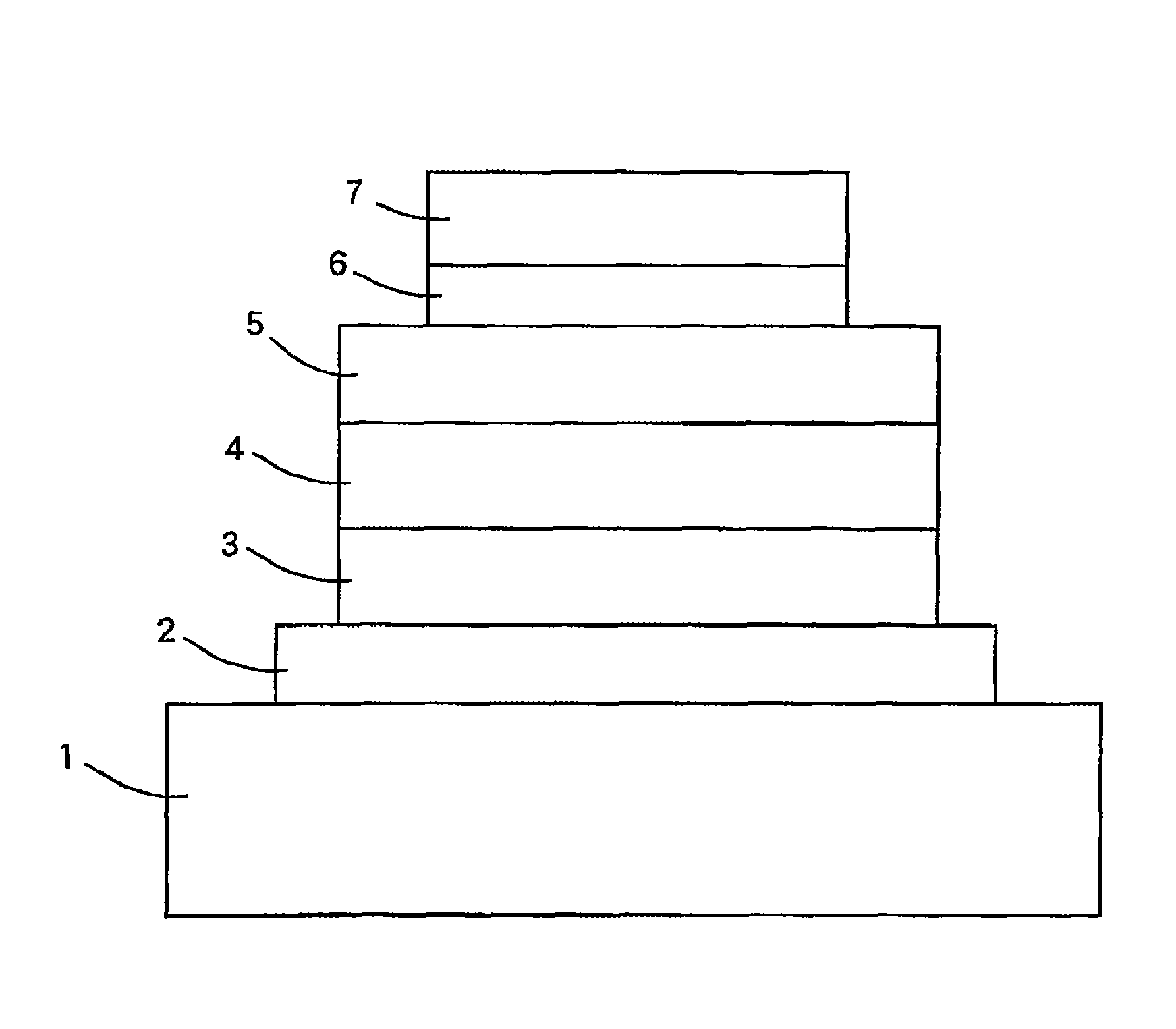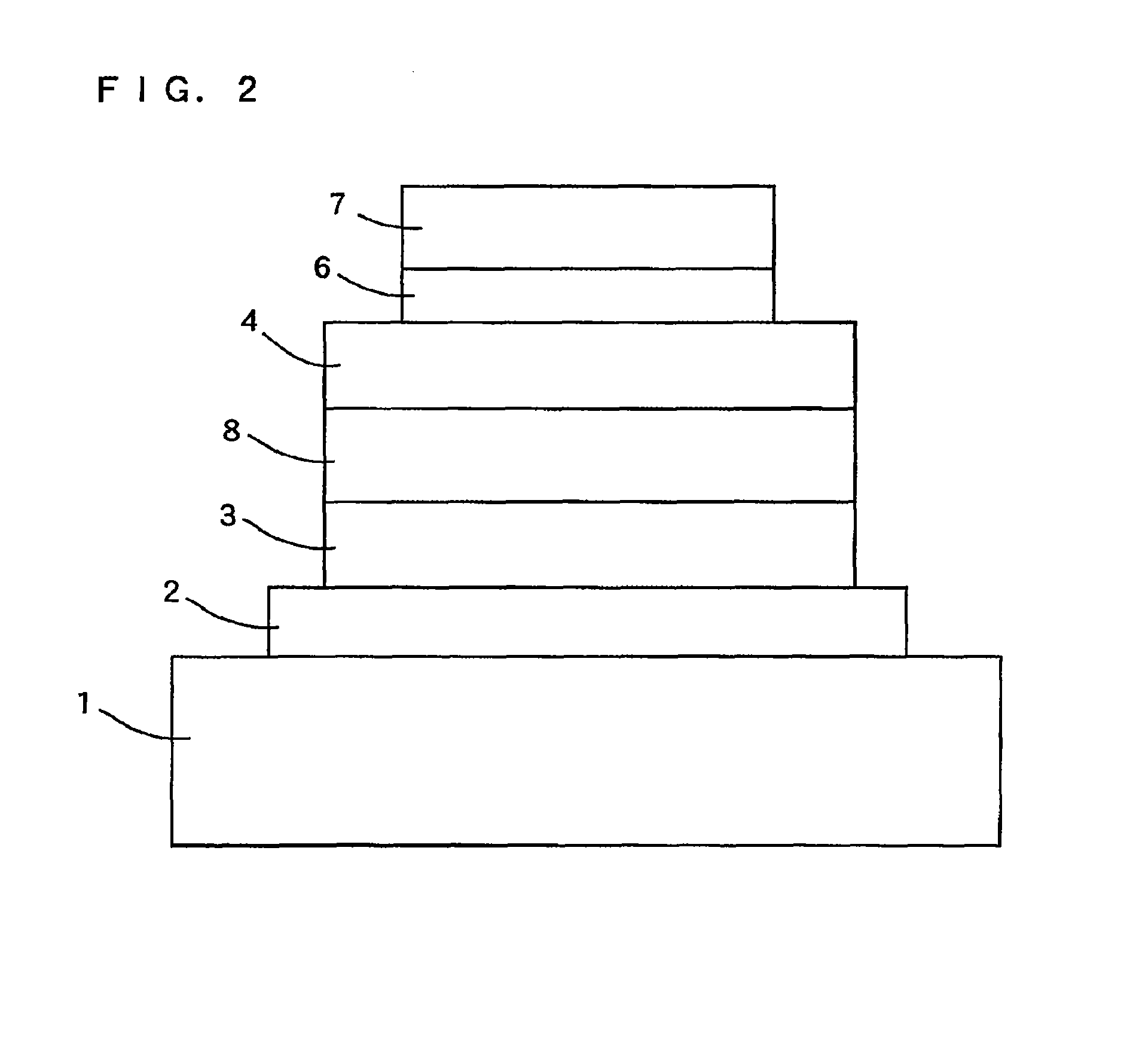Organic electroluminescent device and method for manufacturing same
a technology of electroluminescent devices and organic materials, applied in the direction of solid-state devices, discharge tubes/lamp details, natural mineral layered products, etc., can solve the problem of providing an organic light-emitting device with sufficient luminous efficiency, and achieve the effect of suppressing the influence of the first organic layer and high luminous efficiency
- Summary
- Abstract
- Description
- Claims
- Application Information
AI Technical Summary
Benefits of technology
Problems solved by technology
Method used
Image
Examples
##ventive example 1
Inventive Example 1
[0234]In Inventive Example 1, an organic electroluminescent device having a three-layered structure as shown in FIG. 1 was fabricated in a following method.
[0235]The method of fabricating the organic electroluminescent device according to the Inventive Example 1 will be described. A substrate 1 comprising an anode 2 made of ITO was used. Poly(ethylenedioxythiophene):poly(styrenesulphonate) (a mixture of poly(p-styrenesulfonic acid)salt of [2,3 -dihydrothieno(3,4,-b)(1,4)dioxin-5,7-diyl] and poly(p-styrenesulfonic acid)) (hereinafter called PEDOT:PSS) having a molecular structure represented by the formula (C1) below was formed to have a thickness of 40 nm on the anode 2 by spin coating, and baked at 180 degrees for ten minutes in the atmosphere, thus forming a hole injection layer 3.
[0236]
[0237]Then, MEH-PPV was formed to have a thickness of 40 nm on the hole injection layer 3 by spin coating, and baked at 80 degrees for five minutes in an atmosphere of nitrogen, ...
##ventive example 2
Inventive Example 2
[0258]In Comparative Example 2, an organic electroluminescent device having the three-layered structure shown in FIG. 1 was fabricated in a following method.
[0259]Similarly in the Inventive Example 1, a glass substrate 1 comprising an anode 2 made of ITO was used. As with the Inventive Example 1, PEDOT:PSS was initially formed to have a thickness of 40 nm on the anode 2 by spin coating, and baked at 180 degrees for ten minutes in the atmosphere, thus forming a hole injection layer 3.
[0260]PF6-CVAP was subsequently formed to have a thickness of 40 nm on the hole injection layer 3 by spin coating, and baked at 80 degrees in an atmosphere of nitrogen, thus forming a light emitting layer 4. At this time, the PF6-CVAP was used as a solution of o-dichlorobenzene.
[0261]Then, PF8-DSB was formed to have a thickness of 40 nm on the light emitting layer 4 by spin coating, thus forming an electron transport layer 5 also serving as a hole blocking layer. At this time, the PF8-...
##ventive example 3
Inventive Example 3
[0272]In Inventive Example 3, nine kinds of organic electroluminescent devices having light emitting layers 4 and electron transport layers 5 in different thicknesses were fabricated to evaluate luminescent characteristics. The organic electroluminescent devices in the Inventive Example 3 are similar to the organic electroluminescent device in the Inventive Example 1 in structure and fabrication method except in the thicknesses of the light emitting layers 4 and the electron transport layers 5.
[0273]Table 4 shows thicknesses of the light emitting layer 4 and the electron transport layer 5 of each of the nine kinds of organic electroluminescent devices, 1-1, 1-2, 1-2, 2-1, 2-2, 2-3, 3-1, 3-2, 3-3.
[0274]
TABLE 4LIGHT EMITTINGLAYER THICKNESS (Å)INVENTIVE EXAMPLE 3140260620ELECTRON1601-12-13-1TRANSPORT LAYER3801-22-23-2THICKNESS (Å)6601-32-33-3
[0275](Evaluation 3)
[0276]The nine kinds of organic electroluminescent devices in the Inventive Example 3 were measured for lum...
PUM
| Property | Measurement | Unit |
|---|---|---|
| thickness | aaaaa | aaaaa |
| thickness | aaaaa | aaaaa |
| thickness | aaaaa | aaaaa |
Abstract
Description
Claims
Application Information
 Login to View More
Login to View More - R&D
- Intellectual Property
- Life Sciences
- Materials
- Tech Scout
- Unparalleled Data Quality
- Higher Quality Content
- 60% Fewer Hallucinations
Browse by: Latest US Patents, China's latest patents, Technical Efficacy Thesaurus, Application Domain, Technology Topic, Popular Technical Reports.
© 2025 PatSnap. All rights reserved.Legal|Privacy policy|Modern Slavery Act Transparency Statement|Sitemap|About US| Contact US: help@patsnap.com



